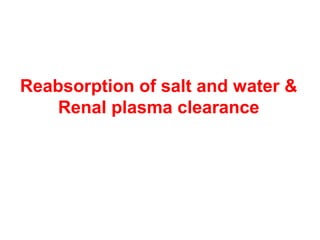
lecture 14 dr fawzy
- 1. Reabsorption of salt and water & Renal plasma clearance
- 2. Reabsorption of salt, water and glucose The kidneys filter about 180 l per day, but the urine excreted is about 1 – 2 l (1%) Per day. This means that 99% of the ultrafiltrate is reabsorbed and 1% excreted. The minimum volume of urine required per day to eliminate the metabolic wastes is 400 ml (obligatory water loss). Water reabsorption in the proximal tubules is by osmosis.
- 3. Salt and water reabsorption
- 4. Reabsorption of glucose Glucose is easily filtered by the glumeruli into the renal tubules. 375 mg/min is reabsorbed and the rest is excreted (Glycosuria). This occur in the proximal tubule by secondary active transport which transport glucose with sodium.
- 5. Reabsorption of salt and water • ~ 65 % of salt and water which were filtered at the glomerulus are reabsorbed back into blood in the proximal tubule. • Another 20% of water is reabsorbed in the descending loop of the Henle. 65% water reabsorbed • The total 85% salt and water which are reabsorbed occur constantly and are 20% water not under any hormonal regulations. reabsorbed • Still a large volume (~ 180 L x 15% = 27 L) is remained to be reabsorbed in the rest of the nephron tubules (distal convoluted tubules and collecting ducts).
- 6. Counter current multiplier system Ascending limb of Descending limb of loop of Henle ~ 100 mOsm loop of Henle goes to distal convoluted tubules and collecting duct. < 300 > 300 > 300 mOsm/L > 300 Water NaCl NaCl Capillary
- 7. Water reabsorption in distal convoluted tubules and collecting duct Distal CT ADH 100 mOsm 300 300 400 400 water Collecting Duct 600 600 NaCl 800 800
- 8. Vasa recta and countercurrent exchange
- 9. The role of urea in the concentration of the urine
- 10. Plasma concentration and antidiuretic hormone ADH
- 11. The final products of the process Composition of the plasma, glomerular filtrate, and the urine: Solute Plasma Filtrate Final urine % reclaimed Urea + + + 50% Glucose + + - 100% Amino acids + + - 100% Total inorganic ions* + + + 95.5% Protein + + - - Organic toxins + + ++ 0% * mainly Na+ and Cl-
- 12. Renal plasma clearance Renal clearance of inulin
- 13. Renal clearance of Inulin measurement of GFR • Inulin is not produced by our cells and it is not metabolized. Also it is fully filtered and neither secreted nor reabsorbed. - Inulin clearance depends on GFR. Inulin filtered = inulin excrected Inulin Filtered = GFR (ml/min) x P (mg/ml) Glomerular Filteration Rate Plasma concentration of Inulin Inulin excreted = V (ml/min) x U (mg/ml) Rate of urine formation Inulin concentration in urine GFR x P = V x U V (ml/min) x U (mg/ml) GFR (ml/min) = P (mg/ml)
- 14. Renal Plasma Clearance of Solutes Clearance of a solute is the volume of plasma that is completely cleared from that solute in one minute. Clearance of inulin (ml/min) = GFR (ml/min) V (ml/min) x U (mg/ml) Clearance (ml/min) = P (mg/ml) - A substance that is filtered and reabsorbed has clearance < GFR or inulin - A substance that is filtered and secreted has clearance > GFR or inulin
- 15. Clearance of Urea -Urea is filtered like inulin but also partially reabsorbed. -So how clearance of urea is compared to GFR? UREA CLEARNCE (ml/min) ? < GFR (ml/min)
- 16. Clearance of Para-aminohippuric Acid (PAH) PAH is filtered like inulin but in addition it is also secreted. -So how clearance of PAH is compared to GFR? PAH (ml/min) > ? GFR (ml/min) PAH is used to measure renal plasma flow.
- 17. Renal control of electrolyte and acid-base balance In the region of the late distal tubule and the cortical collecting duct, reabsorbtion of Na+ results in secretion of K+ and H+. In case of hyperacidity H+ is secreted at the expense of K+ this is why hyperacidity is associated with increase in blood K+. On the other hand hyperkalemia results in secretion of K+ at the expense of H+ causing hyperacidity in the blood. Reabsorption of Na+ and secretion of K+ are regulated by aldosterone.
- 18. Homeostasis of plasma Na+
- 19. Urine formation Filtration is the process of flow of water and dissolved solutes from the blood plasma to the capsule. Reabsorption is the back uptake of water and NaCl, glucose, and amino acids from the tubular fluid to the blood. Secretion is the addition of some substances from the blood capillaries directly into the tubules. Excretion is the elimination of water and some solutes in form of urine.
- 20. Kidney Disease • Glomerulonephritis • It is the inflammation of the glomeruli, or small blood vessels in the kidneys. It may present with isolated hematuria and/or proteinuria (blood or protein in the urine). • Acute Renal Failure • Acute: Sudden onset. Rapid reduction in urine output-usually reversible. • This may be due to infection, drugs, traumatic injury, major surgery, nephrotoxic poisons. • Emergency dialysis may be needed until the situation resolves and the kidneys begin functioning again. • Chronic Renal Insufficiency (CRI) • Slow distruction of the filtering capacity of the kidney. • It is irreversible. • 75% of function can be lost before it is noticeable.